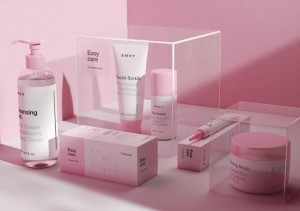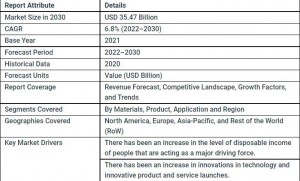Beauty and Personal Care Packaging Market Insights and Industry Analysis By Materials (Plastics, Glass, Metal and other), Product (Bottles, Cans, Tubes, Pouches, Others), Application (Skincare, Cosmetics, Fragrances, Hair care and others) And Region, Competitive Market Size, Share, Trends, and Forecast to 2030.
New York, USA, Jan. 02, 2023 (GLOBE NEWSWIRE) -- Beauty and Personal Care Packaging Market Overview:

According to a Comprehensive Research Report by Market Research Future (MRFR), “Beauty and Personal Care Packaging Market Information By Materials, Product, Application and Region - Forecast till 2030”, the market is estimated to grow at a 6.8% CAGR to reach USD 35.47 Billion by 2030.
Market Scope:
For the purpose of preventing contamination and other forms of damage, personal care packaging refers to the materials used to encase such products. Materials including plastic, flexible packaging, paperboard, glass, and metals fall into this category. Pens, pumps, sprays, sticks, and roller balls are all examples of modern packaging. The demand for cosmetics and other beauty aids has skyrocketed in recent years, and this, combined with developments in packaging technology, has increased interest in more portable and flexible packaging options.
Report Scope:

Competitive Dynamics:
Increased rivalry amongst market participants is expected to boost their ability to meet consumer needs throughout the forecast period. The market players are as follows:
-Amcor Limited (Australia)
-WestRock Company (U.S.)
-Saint-Gobain S.A.(France)
-Bemis Company, Inc. (U.S.)
-Mondi Group (Austria)
-Sonoco Products Company (U.S.)
-Albéa Services S.A.S.(France)
-Gerresheimer AG (Germany)
-Ampac Holdings, LLC (U.S.)
-AptarGroup (U.S.)
-Ardagh Group (Luxembourg)
-HCT Packaging Inc.(U.S )
Market USP:
Market Drivers
During the forecast period ending in 2028, the market for beauty and personal care packaging is expected to grow at a compound annual rate (CAGR) of 4.3%. There has been a surge in technological advances and the introduction of ground-breaking new products and services, both of which will aid in safeguarding product contents and extending their useful life. Because of this, the cosmetics industry has expanded, our need to reduce our carbon footprint has grown, and our consumption habits and habits generally are in a constant state of flux.
During the forecast period ending in 2028, the market is expected to grow at a good rate thanks to the increasing urbanization of developing nations and the rising demand for products that promise good outcomes. In addition, the industry is poised to expand into previously untouched regions throughout the world, with eco-friendly packaging that incorporates natural components and recycling techniques expected to lead the way in the future years.
Market Restraints
However, the price of raw materials, a necessary part of the packaging process, is becoming increasingly volatile and unpredictable, posing a threat to the global beauty and personal care packaging market. There has also been a notable increase in the growth of serious worries about the recycling of products in relation to the raw materials that are being utilized for packaging methods. These are projected to be the most significant market limitations, posing the greatest threat to market expansion throughout the forecast period ending in 2030.
COVID-19 Analysis:
The most upsetting aspect of this pandemic has been the sporadic wavelike patterns in which new cases have started appearing. As the pandemic spreads to other parts of the world, the beauty and personal care packaging market will need to make plans based on the various possible outcomes and assume a greater level of risk. Since essential resources and raw materials are in short supply, it has been difficult for the market to achieve and sustain a state of balance between the forces of demand and supply. There is a shortage of skilled workers, and this limits production levels and the efficiency with which market resources may be utilized. A combination of falling demand and a shortage of key inputs has had a disproportionately negative impact on manufacturing and production facilities over the course of the predicted period ending in 2030.
Market Segmentation:
Based on the material type
The plastics industry is predicted to expand rapidly throughout the assessment time frame.
Based on the product type
For the duration of the study, the pouch category is predicted to account for the largest share of the personal care packaging market based on product type.
Based on application type
All of these end-uses are vital to the continued development of the personal care packaging industry, but the skincare sector in particular is projected to grow at a particularly impressive CAGR over the next years.
Regional Analysis:
For the forecast period ending in 2030, the North American market is anticipated to be the fastest growing regional market. The United States ranks first in sales of perfumes and then cosmetics and personal care items.
As the standard of living in the Asia-Pacific area improves, so does the need for natural and organic skincare products. This is one of the main drivers that will increase the global growth potential of the market in the next years. The need for natural components in cosmetics and similar items is shifting as a result of demographic shifts. The rising demand for grooming and personal care products, as well as the increased interest in new pack sizes, pack formats, and functionalities, are fueling the expansion of the personal care packaging market over the review period. The demand for skin care and other styling aids has been on the rise in this area as individuals become more aware of their advancing years and seek out anti-aging and UV protection goods.
Post time: Jan-04-2023
